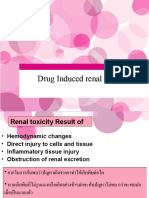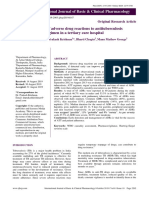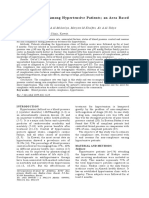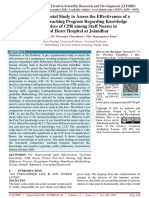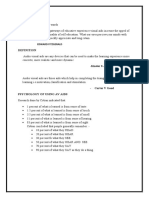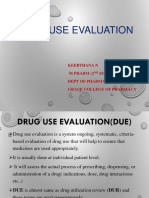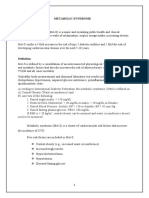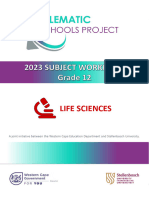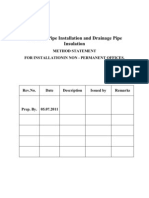A Prospective Study of Prescribing Pattern in The Management of Stroke at A Tertiary Care Hospital
Copyright:
Available Formats
A Prospective Study of Prescribing Pattern in The Management of Stroke at A Tertiary Care Hospital
Original Description:
Original Title
Copyright
Available Formats
Share this document
Did you find this document useful?
Is this content inappropriate?
Copyright:
Available Formats
A Prospective Study of Prescribing Pattern in The Management of Stroke at A Tertiary Care Hospital
Copyright:
Available Formats
Volume 6, Issue 12, December – 2021 International Journal of Innovative Science and Research Technology
ISSN No:-2456-2165
A Prospective Study of Prescribing Pattern in the
Management of Stroke at a Tertiary Care Hospital
LAVANYA S1*, MEET SHAH2, YAMA THAKKAR2, VYOMA PATEL2
1
Department of Pharmacy Practice, P.S.G College of Pharmacy, Peelamedu, Coimbatore
2
Department of Pharmacy Practice, Parul Institute of Pharmacy, Parul University, Vadodara
Corresponding author:
Dr. S. Lavanya., M.Pharm., Ph.D.,
Professor
Department of Pharmacy Practice
PSG College of Pharmacy
Peelamedu, Coimbatore 641004
Abstract:- Stroke is a neurological insufficiency marked I. INTRODUCTION
by an acute focal injury to the central nervous system due
to vascular causes which also includes cerebral infarction, Stroke is a neurological insufficiency marked by an
intracranial haemorrhage along with subarachnoid acute focal injury to the central nervous system due to
haemorrhage. To assess the prescribing pattern in the vascular causes which also includes cerebral infarction,
management of stroke at a tertiary care hospital. A intracranial haemorrhage along with subarachnoid
prospective observational study was carried out for a haemorrhage1. Atherosclerosis is a causative factor in most
period of 6 months in both ischemic and hemorrhagic cases of ischemic stroke, which particularly of the cerebral
stroke patients with age group between 18 – 90 years. vasculature. Emboli can arise either from intra- or extra-
Patient demographic and other data’s were collected cranial arteries (including the aortic arch) or, as is the case in
using a specially designed data collection form. The 20% of all ischemic strokes, the heart. Cardiogenic embolism
Modified rankin scale was used to measure the severity of is presumed to have occurred if the patient has concomitant
stroke. All the data was analyzed using graphpad. A total atrial fibrillation, valvular heart disease, or any other
of 100 patients were enrolled in the study. Male gender condition of the heart that can lead to clot formation2.
(60%) was more prone to stroke, majorly in the age group Haemorrhagic stroke is caused by a weakened vessel which
of 60-80 years of age along with the social risk factors like ruptures and bleeds into the surrounding regions of brain.
tobacco (21%) and smoking (20%). Hypertension (52.38) This blood accumulates and compresses the brain tissue
was found as a dominant past medical history in stroke surrounding it3.
patients. The prescribing pattern in the management of
stroke were appropriate to the condition of the patient Cerebrovascular disease is the second leading cause of
which comprises of anti-platelets (27%), anti-lipidemic death worldwide, accounting for 10% of all deaths. The most
(26%), anti-hypertensive (26%) and other medications common form of cerebrovascular disease is stroke. It is
for the treatment of the comorbid conditions such as considered as one of the second major causes of death and the
hypertension (52%), diabetes (17%), dyslipidemia and rate of mortality in India ranging from 262 strokes /10000
other conditions. The duration of stay (22 days) is directly patients in rural to significantly higher rates of 424
proportional to the extent of disability of the patient as patients/10000 people in urban area of India. India lost a
well as the comorbidities which invariably increases the whopping 870 crores in 2005 due to stroke and it was
cost of therapy. The direct medical cost was found to be estimated to increase the cost to almost 5500 crores and
linearly proportional to the extent of disability and combined loss of 1% of gross GDP. The in-patient cost itself
comorbid condition of the patient. Cerebrovascular accounted for almost 70% of the total treatment cost and
stroke is a crucial public health problem and thus it is severe stroke costs almost twice as much as mild stroke4.
vital to monitor the prescribing patterns and its
management. The need of clinical pharmacist is needed to A blood vessel in the brain bursts and spills into the
facilitate recovery of the patient and enhance the surrounding brain tissue damaging the brain cells.
healthcare experience along with reducing the economic Haemorrhagic strokes are due to rupture of blood vessels
burden and length of stay in hospital so as to decrease leading to compression of brain tissue from expanding
morbidity and mortality. hematoma. This distorts and injures the tissue; pressure may
lead to loss of blood supply to affected tissues leading to
Keywords:- Stroke, Prescribing Pattern, Management, infarction. Blood released by the brain haemorrhage appears
Modified Rankin Scale, Hypertension, Cost. to have direct toxic effects on brain tissue and vasculature.
IJISRT21DEC687 www.ijisrt.com 1132
Volume 6, Issue 12, December – 2021 International Journal of Innovative Science and Research Technology
ISSN No:-2456-2165
A blood vessel in the brain bursts and spills into the II. MATERIAL AND METHODS
surrounding brain tissue damaging the brain cells.
Haemorrhagic strokes are due to rupture of blood vessels A. Study Design
leading to compression of brain tissue from expanding The study on the prescribing pattern in the management
hematoma. This distorts and injures the tissue; pressure may of stroke is assessed through a prospective and observational
lead to loss of blood supply to affected tissues leading to study, over a period of 6 months, at a tertiary care hospital,
infarction. Blood released by the brain haemorrhage appears Vadodara.
to have direct toxic effects on brain tissue and vasculature5.
The patient may experience weakness on one side of the B. Study Duration:
body, inability to speak, loss of vision, vertigo, or falling. 6 months (September 2019 – March 2020)
Ischemic stroke is not usually painful, but headache may
occur and may be severe in haemorrhagic stroke.
Pharmacotherapeutic Proficiency is of importance at multiple C. Target Population
points in this CVS care process, and should be well In the present study, patients with hemiplegia, slurred
documented in the management pathway. CVS units are speech, facial droop and who are diagnosed to have ischemic
increasingly using these documents in both, acute and the and haemorrhagic stroke with assessing severity through
rehabilitation phases. The added advantage of an intricate Modified Rankin scale are the target population. Patients
rehabilitation path, initiated for each and every patient on admitted in the general medicine ward and ICU is included in
hospital admission, is that it lists the level of multidisciplinary the study. The study criteria includes patients diagnosed with
treatment that the particular patient should get. To educate the stroke, patients of either gender with >18 and <90 years of
patient through counselling using verbal as well as well age and excludes the patients <18 years of age and special
written medication guidance, which could include patient population of pregnant and lactating womens.
information leaflets or a medication reminder sheet. The
reminder chart should comprise of detailed information D. Ethical Consideration
regarding the use for the medications, route and time to take The study proposal is obtained from Institutional Ethical
them, and the possible routine adverse effects(if any). The Committee of Parul Sevashram Hospital, Vadodara and
high importance of chronic prophylactic treatment, such as approval No: PUIECHR/PIMSR/00/081734/2301.The study
anti-platelet, anti-HTN and lipid- lowering therapy, must be is carried out among the stroke patients and the purpose of the
communicated to the CVS patient, to assess the possible study was well explained to the participants. An informed
compliance. After a stroke attack, the sufferers may face consent is obtained and maintained confidentially.
discomfort in taking their prescribed supportive secondary
prevention therapy. These compliance issues may come from E. Designing Of Patient Data Collection Form
any impairment in personal dexterity or cognitive function as A specially designed patient data collection form is
a result of stroke. To evaluate drug-drug interactions and this prepared and validated. The data form was structured to
can affect patient’s clinical outcomes, quality of life and obtain the demographic details of stroke patients. Patient data
contribute to unnecessary health care costs. To have collection form is given in and is used to collect the necessary
partnered with general medical practitioners and community information from the patient medical records which consists
pharmacists on discharge. There should be pre-decided of patient demographic details (name, age and gender), social
processess to ensure that the patient’s family physician and and family history, patient present complaints, past medical
community pharmacist get written therapeutic discharge and medication history, co- morbidities, blood pressure,
information. This must include alterations to medication, length of stay, laboratory data and medication regimen with
different formulations of medication and nutraceuticals. To their dose and route of administration.
take into consideration the individual patient’s present
conditions, the pharmacist can help them take necessary step Study Tools
towards a better lifestyle and improved medication use. To The modified Rankin Scale (mRS) is a commonly used
build efficient communication channels with the different scale for measuring the degree of disability or dependence in
healthcare professionals involved in the CVS team6. the daily activities of people who have suffered from stroke.
The mRS is a 7-level ordered categorical scale capturing
levels of patient functional independence following a stroke.
IJISRT21DEC687 www.ijisrt.com 1133
Volume 6, Issue 12, December – 2021 International Journal of Innovative Science and Research Technology
ISSN No:-2456-2165
Data Analysis cardiogenic embolism, most typically from atrial fibrillation.
The collected data are tabulated and statistically A variety of other occlusive disorders may be the primary
analysed. Different types of graph, figure and tables are used cause or variably contribute to stroke pathogenesis.
to summarize the data visually.
B. Percentage Distribution of Comorbidities
Statistical Analysis Patients with Hypertension as a comorbid condition
The statistical analysis is performed using GRAPHPAD were found to be highest among 92 patients that is 66 patients
PRISM. All data was expressed as mean ± standard deviation. (52.38%).
We used paired student t-test is used. P<0.05 was considered
as statistically significant.
III. RESULTS AND DISCUSSION
DM + HTN +
Out of 100 patients, 92 patients were enrolled for the Dyslipidemia 1.58%
study, and 8 patients were drop-outs. Baseline characteristics
were calculated initially. The baseline characteristics of the
study population are presented in Table 3. The clinical Diabetes +
characteristics are such as: Mean age ± SD in Population (60 hypertension 12.69%
± 11 years), Male gender (59%) and female gender (41%),
Mean length of hospital stay in Population (22 ± 12 days).
Dyslipidemia
15.87%
A. Types of Stroke
Out of 92 patients majority of the patients were found to
be suffering from ischemic stroke (89%), followed by Hypertension
hemorrhagic stroke (9%). 52.38%
Diabetes
17.46%
9%2% Fig 2: Comorbid Conditions
In the previous decades, the CVS prevalence has shown
upward trend with patient age. It may be attributed to the
greater incidence of HTN, Diabetes mellitus, dyslipidaemia,
sedentary lifestyle, and alterated dietary habits. A Study by
Renjen et al.32 demonstrated that the typical age of stroke
89% patients were 57.1 ± 1.7 years which is relatable to our study
during which the mean age was 59.7 +11. Multiple studies in
Ischemic HAEMORRHAGIC TIA the past indicates that the risk of CVS increases two fold for
every successive decade after the age of 55 years8,9. HTN
Fig 1: Types of Stroke
affects innumerable people across the globe and is a
significant risk factor for both cerebral infarction as well as
The incidence of haemorrhagic stroke is 20% whereas
intracerebral hemorrhage 10. The greater the blood pressure,
that of ischemic was 80%. Our study reported that ischemic
higher will be the risk for risk as per Lewington et al.11.
stroke (89%) was more prevalent followed by (9%)
Chobanian et al., indicated that optimum control of high BP
haemorrhagic and (2%) TIA. Ischemic stroke is a major type
contributes to stroke prevention12 . Risk of getting a stroke
of stroke was also observed in previous study conducted by
are often reduced by minimum 38% by regulation of HTN,
Abbasi7. Up to 85 % of all strokes are of ischaemic origin.
McMahon and Rodgers13. Hypertension as a risk factor was
Atherosclerosis of the arteries that supply the brain is the
detected in 53.8% of our studied patients which was almost
most observed cause of ischaemic stroke. There can be large
close to 56.9% as per Renjen et al., 201514. The contribution
artery atherosclerotic infarction which occurs when there’s a
of dyslipidemia within the progress of cerebrovascular
hindrance to normal perfusion, usually caused by a severe
disease is less certain than that for CAD; more prominent
arterial stenosis or due to atherosclerosis and coexisting
association has been obsereved with decreased high-density
thrombosis. Microatheroma, lipohyalinosis, and other
lipoprotein (HDL) cholesterol and increased total cholesterol
occlusive diseases of the small penetrating brain arteries are
to HDL ratio than with the total cholesterol level, LDL
the most frequent causes of small, sub-cortical lacunar
cholesterol and triglycerides. Dyslipidemia was found in
infarcts. About 20 % of ischaemic strokes are due to
17.45% of our patients which was slightly lower than the
IJISRT21DEC687 www.ijisrt.com 1134
Volume 6, Issue 12, December – 2021 International Journal of Innovative Science and Research Technology
ISSN No:-2456-2165
study conducted by Renjen et al. Diabetes was a contributing C. Clinical Presentation
risk factor found in 19.04% of cases in this study which is Among all the clinical manifestations like hemiparesis,
consistent to the studies performed by Lai SL et al15. hemiplegia, aphagia, slurred speech, unconsciousness,
headache, confusion, convulsions etc., the most commonly
observed manifestations were slurred speech(20.8%),
hemiplegia(19.07%) .
25
20
15
20.8
10 19.07
13.87
11.56
5 9.2
6.93 5.7 5.7 4.6
2.3
0
Fig 3: Clinical Manifestations of Stroke
In our recent study most of the patients presented with 35
predominant symptoms like slurred speech (Speech defects),
PERCENTAGE OF PATIENTS
change in speech followed by weakness on the right side, 30
headache, weakness on the left side and deviation of the
mouth. In our study it absolutely was observed that maximum 25
patients presented with slurred speech (20.8%), followed by
hemiplegia (19.7%), hemiparesis (13.87%), giddiness 20
(11.56%), facial droop (9.2%), confusion (6.93%), aphagia
(5.7%), headache (5.7%), unconsciousness (4.6%) and 15
convulsion (2.3%). These findings were in concordance with
the study conducted by Aiyar 16. 10
D. Disability on Admission 5
On the Basis of mRS Score of 92 patients, the extent of
disability on admission was calculated and 32 patients had a 0
mRS score of 3(34.78%) followed by 27 Patients with mRS 0 2 4 6 8
score of 4(29.34%). mRS Score
Fig 4: mRS Score on Disability
Functional disability is strongly correlated to the cost of
stroke within the years after the stroke event. The results from
this study indicate higher costs with worse functional
disability, there’s a rise in average per-patient costs after
stroke (comparing mRS 5 to mRS 0–2). These conclusions
hold even after stratifying the results by different age groups.
This sensitivity analysis further indicated that the youngest
population (<60) incurred the highest costs in any level of
IJISRT21DEC687 www.ijisrt.com 1135
Volume 6, Issue 12, December – 2021 International Journal of Innovative Science and Research Technology
ISSN No:-2456-2165
disability. Previous study by Lekander I. et al., have also rehabilitation in order to maintain optimum functional ability
indicated an analogous relationship between functional in the years after stroke.
disability and costs. 47 If a treatment can reduce a patient’s
functional disability from mRS 4–5 to mRS 0–2, the potential E. Prescribing Patterns In Stroke Patients
benefit could possibly be substantial also in terms of financial Amongst 92 patients, 80 Patients were prescribed anti-
terms. It also focuses on the importance of the continuous platelets (27%), 76 Patients were prescribed anti-lipidemic,
and69 Patients were prescribed antihypertensive.
5%
9%
27%
10%
Anti Platelet
Anti Lipidemic
Anti HTN
Anti Diabetic
AntiPsychotic
Anti Coagulant
23%
26%
Fig 5: Prescribing Pattern of Drugs
In the present study, most of the patients were The anti-hypertensives followed are Angiotensin
prescribed with anti-platelets (aspirin, clopidogrel) and receptor blocker (21%), beta blockers (20%), diuretics (10%),
dyslipidemics (atorvastatin) which is comparable to the Angiotensin converting enzyme (5%) and centrally acting
findings conducted by Prathyusha et al. where the identical antihypertensive (4%).
drugs were prescribed in stroke patients17.
IV. CONCLUSION
In previous study conducted by Johnston et al., the
majority of patients with minor ischaemic stroke or high-risk The prescribing pattern in stroke patients is not well
TIA, received a combination of clopidogrel and aspirin which known to the medical world owing to the limited number of
cause a lower risk of major ischemic events whereas higher studies conducted worldwide on it. Stroke is a disease which
risk of major haemorrhage at 90 days than those that received causes long duration of hospital stay of patient because of the
aspirin alone18. This is in concordance with our study within slow recovery of the patient and the other secondary assistive
which most typically prescribed anti-platelets in our study therapies to the patient. The duration of stay directly varies
were combination of Aspirin and Clopidogrel (72%) with the extent of disability of the patient which invariably
followed by aspirin only (23%) and clopidogrel( 3%). increases the cost of therapy and increases and mortality and
morbidity of patient.
Other drugs prescribed in our study are Atorvastatin
(26%), and Amlodipine (23%), antidiabetic (10%), Antihypertensive drugs have a supporting role in the
antipsychotic (9%) and anticoagulants (5%). management of the disease by controlling the BP and
therefore regularizing the vascular supply. Atorvastatin was
In all category of antihypertensive calcium channel the most commonly prescribed drug for treating
blockers were used employed in majority of prescriptions dyslipidemia. Drugs prescribed for the treatment of stroke
(26%), which is comparable to study conducted by Abbasi et were according to AHA/ASA guidelines. Majority of the
al. prescriptions were rational and the findings necessitate the
early and appropriate management of stroke to prevent
further complications of stroke. Such long term therapy
involves a major economic burden on the patient including
IJISRT21DEC687 www.ijisrt.com 1136
Volume 6, Issue 12, December – 2021 International Journal of Innovative Science and Research Technology
ISSN No:-2456-2165
the direct, indirect healthcare cost along with intangible
expenses incurred to the patient. The presence of comorbid
condition such as hypertension or diabetes results in
increased costs of treatment due to it complicated treatment
regimens and high drug pricing. The therapy cost is directly
proportional to the extent of disability of patient upon
admission as more disability results into longer and
complicated therapies.
Physiotherapy, lifestyle changes and better management
of risk factors have a major effect on recovery of stroke with
improve quality of life and symptoms. There is a need of
clinical pharmacist and healthcare team for the management
of stroke to facilitate speedy recovery of the patient, to
enhance the healthcare experience for the patients, reducing
the economic burden, eliminating drug related issues and
length of stay in hospital.
REFERENCES
[1]. Ralph L S, Scott E K, Joseph P B, Louis R C, Buddy C,
Antonio C, et al. Stroke, 2013; 44 Suppl 7:2064-89.
[2]. DiPiro, J. Pharmacotherapy. 7th ed. New York:
McGraw-Hill Publishers; 2008.
[3]. Hemorraghic Stroke. https://www.stroke.org/en/about-
stroke/types-of- stroke/hemorrhagic-strokes-bleeds
(2020).
[4]. Khurana D, Padma V, Bhatia R, Kaul S, Sylaja PN. J.
Stroke Med, 2018; 1 Suppl 2:79-113.
[5]. Edward CJ, Franchis T, Charles R W. Drugs &
Diseases, 2020; 1:1-6.
[6]. Derek T. The pharmacist’s role in a stroke unit, 2004:
https://hospitalpharmacyeurope.com/news/editors-
pick/the-pharmacists-role-in-a-stroke-unit/.
[7]. Abbasi M, Ali MA. Archives of Pharmacy Practice,
2012; 3 Suppl 4:283-288.
[8]. Brown RD, Whisnant JP, Sicks JD, Fallon WM,
Wiebers DO. Stroke, 1996; 27 Suppl 3:373-80.
[9]. Wolf PA, Agostino RBD, Neal MA, Sytkowski P, Kase
CS, Belanger AJ, et al. Stroke, 1992; 23 Suppl 11:1551-
5.
[10]. Fields LE, Burt VL, Cutler JA, Hughes J, Roccella EJ,
Sorlie P. Hypertension, 2004; 44 Suppl 4:398-404.
[11]. Lewington S. The Lancet, 2002; 360:1903-1913.
[12]. Chobanian AV, Bakris GL, Black HR, Cushman WC,
Green LA, Jones DW, et al. JAMA 2003; 289 Suppl
19:2560-72.
[13]. Kaur G, Samar N, Sharma J, Pareek KK, Veerwal R,
Kajila P, et al. Clin Exp Hypertens 1996; 68:537-46.
[14]. Renjen PN, Beg MA, Ahmad K. Int J Med Public
Health, 2015; 5 Suppl 1:50-54.
[15]. Lai SL, Weng HH, Lee M, Hsiao MC, Lin LJ, Huang
WY. Eur Neurol, 2008; 60: 230-6.
[16]. Donnell MJD, Liu L, Zhang H. Gujarat medical
Journal, 1999; 52:58-63.
[17]. Preethi PB, Naveed A, Shreya S, Lakshmi SG, Rao V.
Indo Am J Pharm Res, 2014; 4 Suppl 2:1015-20.
[18]. Johnston S, Easton D, Farrant M, Barsan W, Robin A,
Anthony S, et al. N Engl J Med, 2018; 379:215-225.
IJISRT21DEC687 www.ijisrt.com 1137
You might also like
- Assessment of Adverse Drug Reactions To AntitubercNo ratings yetAssessment of Adverse Drug Reactions To Antituberc5 pages
- Adverse Medication Response Recorded in A Referral Health Facility: An Observational Study100% (1)Adverse Medication Response Recorded in A Referral Health Facility: An Observational Study6 pages
- Tonsillitis, Tonsillectomy and Adenoidectomy: - Literature ReadingNo ratings yetTonsillitis, Tonsillectomy and Adenoidectomy: - Literature Reading52 pages
- Drug Compliance Among Hypertensive PatientsNo ratings yetDrug Compliance Among Hypertensive Patients5 pages
- Case Presentation On Recurrent PULMONARY EMBOLISM100% (1)Case Presentation On Recurrent PULMONARY EMBOLISM14 pages
- Pulmonary Embolism Is A Common and Potentially Lethal ConditionNo ratings yetPulmonary Embolism Is A Common and Potentially Lethal Condition13 pages
- Conceptual Frame Work For Structured Nursing Rounds On The Level of Patient Satisfaction and Job Satisfaction Among Nurses by Using Ludwig Von Bertalanffy General Systems TheoryNo ratings yetConceptual Frame Work For Structured Nursing Rounds On The Level of Patient Satisfaction and Job Satisfaction Among Nurses by Using Ludwig Von Bertalanffy General Systems Theory3 pages
- Legalandethicalissuesincriticalcarenursing 130411224544 Phpapp02No ratings yetLegalandethicalissuesincriticalcarenursing 130411224544 Phpapp0233 pages
- Surviving Sepsis Campaign 2016 Guidelines Presentation FinalNo ratings yetSurviving Sepsis Campaign 2016 Guidelines Presentation Final60 pages
- A Pre Experimental Study To Assess The Effectiveness of A Competency Teaching Program Regarding Knowledge and Practices of CPR Among Staff Nurses in Sacred Heart Hospital at JalandharNo ratings yetA Pre Experimental Study To Assess The Effectiveness of A Competency Teaching Program Regarding Knowledge and Practices of CPR Among Staff Nurses in Sacred Heart Hospital at Jalandhar40 pages
- Assess The Effectiveness of Structured Teaching Programme On Knowledge of HPV Infection & Vaccination Among Adolescent's Girls at Selected School in Greater Noida, UPNo ratings yetAssess The Effectiveness of Structured Teaching Programme On Knowledge of HPV Infection & Vaccination Among Adolescent's Girls at Selected School in Greater Noida, UP3 pages
- Original Article A Study On Patient Safety Culture Among Nurses in A Tertiary Care Hospital of PuducherryNo ratings yetOriginal Article A Study On Patient Safety Culture Among Nurses in A Tertiary Care Hospital of Puducherry7 pages
- The Effect of Structured Teaching Program On Knowledge About Arterial Blood Gas Analysis Among The Staff Nurses Working in Critical Care UnitNo ratings yetThe Effect of Structured Teaching Program On Knowledge About Arterial Blood Gas Analysis Among The Staff Nurses Working in Critical Care Unit7 pages
- A Study to Assess the Effectiveness of Video Assisted Teaching Module on Knowledge Regarding Myocardial Infarction and its Prevention among the Patients Attending Diabetic Clinic at BVV Sangha’s HSK Hospital and Research Centre, BagalkotNo ratings yetA Study to Assess the Effectiveness of Video Assisted Teaching Module on Knowledge Regarding Myocardial Infarction and its Prevention among the Patients Attending Diabetic Clinic at BVV Sangha’s HSK Hospital and Research Centre, Bagalkot3 pages
- A Descriptive Study To Assess The Knowledge and Attitude Regarding Self Administration of Insulin Injection Among Diabetes Mellitus Patients in Rural Area at DehradunNo ratings yetA Descriptive Study To Assess The Knowledge and Attitude Regarding Self Administration of Insulin Injection Among Diabetes Mellitus Patients in Rural Area at Dehradun5 pages
- Tugas Kelompok: Proseducer Intravenous InjectionNo ratings yetTugas Kelompok: Proseducer Intravenous Injection4 pages
- Blood Transfusion: Etiology of Blood CellNo ratings yetBlood Transfusion: Etiology of Blood Cell4 pages
- Attitudes of Hemodialysis Patients, Medical and Nursing Staff Towards Patients' Physical ActivityNo ratings yetAttitudes of Hemodialysis Patients, Medical and Nursing Staff Towards Patients' Physical Activity12 pages
- Attitude of Nurses in Government Health Institutions Towards Sickle Cell PersonsNo ratings yetAttitude of Nurses in Government Health Institutions Towards Sickle Cell Persons64 pages
- Pulmonary Arterial Hypertension in Congenital Heart Disease: Eisenmenger’s Syndrome - A Global PerspectiveFrom EverandPulmonary Arterial Hypertension in Congenital Heart Disease: Eisenmenger’s Syndrome - A Global PerspectiveNo ratings yet
- A Study on Investor Decision Making and Buying Motives on Gold InvestmentNo ratings yetA Study on Investor Decision Making and Buying Motives on Gold Investment4 pages
- Addressing IoT-Driven Cybersecurity Risks in Critical Infrastructure to Safeguard Public Utilities and Prevent Large-Scale Service DisruptionsNo ratings yetAddressing IoT-Driven Cybersecurity Risks in Critical Infrastructure to Safeguard Public Utilities and Prevent Large-Scale Service Disruptions18 pages
- Enhancing Regression Diagnostics: Automated Residual Analysis Using Computer Vision and Statistical InsightsNo ratings yetEnhancing Regression Diagnostics: Automated Residual Analysis Using Computer Vision and Statistical Insights10 pages
- Helfine: Real-Time Helmet Violation Detection with Automated Fine SystemNo ratings yetHelfine: Real-Time Helmet Violation Detection with Automated Fine System8 pages
- Geographical Appraisal on Spatial Pattern of the Declassification Trends among Census Towns in West BengalNo ratings yetGeographical Appraisal on Spatial Pattern of the Declassification Trends among Census Towns in West Bengal20 pages
- Enhancing Customer Satisfaction in Nepalese Banks and Financial Institutions: The Influence of Service Quality on Different DimensionsNo ratings yetEnhancing Customer Satisfaction in Nepalese Banks and Financial Institutions: The Influence of Service Quality on Different Dimensions11 pages
- Contribution of Agency Banking to the Growth of Economic Activities in Cross River State, NigeriaNo ratings yetContribution of Agency Banking to the Growth of Economic Activities in Cross River State, Nigeria6 pages
- A Participatory Evaluation of Child Labor in the Shea Value Chain in Northern GhanaNo ratings yetA Participatory Evaluation of Child Labor in the Shea Value Chain in Northern Ghana11 pages
- Adolescent Girls’ Knowledge Regarding Menstrual Hygiene at Institute of Public Health School and College, Mohakhali, DhakaNo ratings yetAdolescent Girls’ Knowledge Regarding Menstrual Hygiene at Institute of Public Health School and College, Mohakhali, Dhaka11 pages
- Effects of Entrepreneurship and Entrepreneurial Mentorship in the Promotion of Economic Development in NigeriaNo ratings yetEffects of Entrepreneurship and Entrepreneurial Mentorship in the Promotion of Economic Development in Nigeria7 pages
- Teaching and Learning Enhancement using Computer Vision and Generative AINo ratings yetTeaching and Learning Enhancement using Computer Vision and Generative AI9 pages
- A Study on Optimizing Supply Chain Resilience: Emergency Parts Ordering AnalysisNo ratings yetA Study on Optimizing Supply Chain Resilience: Emergency Parts Ordering Analysis6 pages
- A Research on Labor, Finance, Technology, and Sustainable GrowthNo ratings yetA Research on Labor, Finance, Technology, and Sustainable Growth28 pages
- Smart Farming System with Cloud AnalyticsNo ratings yetSmart Farming System with Cloud Analytics10 pages
- Assessment of Heavy Metals in Ambient Air in the Patancheru Area, Sangareddy District, TelanganaNo ratings yetAssessment of Heavy Metals in Ambient Air in the Patancheru Area, Sangareddy District, Telangana16 pages
- Stroke Prediction using Machine LearningNo ratings yetStroke Prediction using Machine Learning6 pages
- Women Leadership, Transformation and Cultural Conflict: Evidence from the LiteratureNo ratings yetWomen Leadership, Transformation and Cultural Conflict: Evidence from the Literature25 pages
- Security Staffing Strategic Plan for Organizations Security Posture EnhancementNo ratings yetSecurity Staffing Strategic Plan for Organizations Security Posture Enhancement8 pages
- Statistical Models for Prediction of Treatment Response Patterns among Diverse Ethnic Populations with Breast CancerNo ratings yetStatistical Models for Prediction of Treatment Response Patterns among Diverse Ethnic Populations with Breast Cancer28 pages
- Analysis of Components for BPR Implementation in the Public Sector, Focusing on Online Service Delivery in TanzaniaNo ratings yetAnalysis of Components for BPR Implementation in the Public Sector, Focusing on Online Service Delivery in Tanzania16 pages
- Adolescence Emotional Separation and Detachment from ParentsNo ratings yetAdolescence Emotional Separation and Detachment from Parents3 pages
- The Non-Linear Impact of Natural Gas Production on Nigeria’s Industrial Sector: Unraveling the Growth Paradox and Investment DynamicsNo ratings yetThe Non-Linear Impact of Natural Gas Production on Nigeria’s Industrial Sector: Unraveling the Growth Paradox and Investment Dynamics11 pages
- Maternal and Fetal Outcomes after Emergency Caesarian Sections at Bashair Teaching Hospital, Khartoum State, Sudan, 2022No ratings yetMaternal and Fetal Outcomes after Emergency Caesarian Sections at Bashair Teaching Hospital, Khartoum State, Sudan, 202211 pages
- Evaluating the Computational Efficiency and Precision of Pathfinding AlgorithmsNo ratings yetEvaluating the Computational Efficiency and Precision of Pathfinding Algorithms8 pages
- The Role of Paradigm Shifts in Scientific Innovation: Analysis of Kuhn’s Concept of Scientific Revolutions with Modern Case StudiesNo ratings yetThe Role of Paradigm Shifts in Scientific Innovation: Analysis of Kuhn’s Concept of Scientific Revolutions with Modern Case Studies9 pages
- Comparison of Sonographic Features, FNAC, and Histopathological Findings in Patients with Thyroid Swelling100% (1)Comparison of Sonographic Features, FNAC, and Histopathological Findings in Patients with Thyroid Swelling6 pages
- The Role of Ethical Hacking and AI in Proactive Cyber Defense: Current Approaches and Future PerspectivesNo ratings yetThe Role of Ethical Hacking and AI in Proactive Cyber Defense: Current Approaches and Future Perspectives8 pages
- An In-Depth Review of Secretome Therapy Approaches in Medical Practice Secretome Therapy in MedicineNo ratings yetAn In-Depth Review of Secretome Therapy Approaches in Medical Practice Secretome Therapy in Medicine6 pages
- A Case Report of Anti-Phospholipid Syndrome in a Male with Recurrent Deep Vein ThrombosisNo ratings yetA Case Report of Anti-Phospholipid Syndrome in a Male with Recurrent Deep Vein Thrombosis2 pages
- Factors Influencing Uptake of Sexual Reproductive Health Services Among Female Students at Maseno University KenyaNo ratings yetFactors Influencing Uptake of Sexual Reproductive Health Services Among Female Students at Maseno University Kenya13 pages
- Life Sciences Grade 12 Telematics Workbook - 2023No ratings yetLife Sciences Grade 12 Telematics Workbook - 202319 pages
- Sample Brgy Ordinance Creating TB Task Force80% (5)Sample Brgy Ordinance Creating TB Task Force2 pages
- Muhammad Haris Naveed 93072 - Muhammad - Haris - Naveed - Lifeboat - Dilemma - 703371 - 41803400No ratings yetMuhammad Haris Naveed 93072 - Muhammad - Haris - Naveed - Lifeboat - Dilemma - 703371 - 418034006 pages
- Method Statement For AC Units Pipe Installation and Drainage - CatNo ratings yetMethod Statement For AC Units Pipe Installation and Drainage - Cat8 pages
- Bhanu Aunty Fantasy Naku Manchi ExperianceNo ratings yetBhanu Aunty Fantasy Naku Manchi Experiance5 pages
- RG Cybersecurity From Inside Out Case StudyNo ratings yetRG Cybersecurity From Inside Out Case Study10 pages
- Iom Duplex Filter Ap - 142 - 05 - Ow - GB Rev 4 2021No ratings yetIom Duplex Filter Ap - 142 - 05 - Ow - GB Rev 4 202112 pages
- Volume 1 Fire Protection Systems Testing and Commissioning ProceduresNo ratings yetVolume 1 Fire Protection Systems Testing and Commissioning Procedures7 pages
- A HPAE-PAD Chromatographic Assay For Carbohydrates in Urine As A Measure of Intestinal PermeabilityNo ratings yetA HPAE-PAD Chromatographic Assay For Carbohydrates in Urine As A Measure of Intestinal Permeability7 pages
- Cummins QSK45 Engine Spare Parts Catalog: Part Number DescriptionNo ratings yetCummins QSK45 Engine Spare Parts Catalog: Part Number Description19 pages
- Sports: Tapering and Peaking Maximal Strength For Powerlifting Performance: A ReviewNo ratings yetSports: Tapering and Peaking Maximal Strength For Powerlifting Performance: A Review17 pages
- Instant download Islands of Genius The Bountiful Mind of the Autistic Acquired and Sudden Savant 1st Edition Darold A. Treffert pdf all chapter100% (5)Instant download Islands of Genius The Bountiful Mind of the Autistic Acquired and Sudden Savant 1st Edition Darold A. Treffert pdf all chapter81 pages
- Expansion of SUBWAY in China: Research Report100% (1)Expansion of SUBWAY in China: Research Report26 pages
- Preliminary Calculations For The Design of A BeamNo ratings yetPreliminary Calculations For The Design of A Beam2 pages
- FREE DOWNLOAD Kathy DeGraw Covid Declarations100% (1)FREE DOWNLOAD Kathy DeGraw Covid Declarations3 pages
- Process Safety: Blind Spots and Red Ags: March 2011No ratings yetProcess Safety: Blind Spots and Red Ags: March 20117 pages
- No Product Name Qty: Berita Acara Uji FungsiNo ratings yetNo Product Name Qty: Berita Acara Uji Fungsi7 pages
- Assessment of Adverse Drug Reactions To AntitubercAssessment of Adverse Drug Reactions To Antituberc
- Adverse Medication Response Recorded in A Referral Health Facility: An Observational StudyAdverse Medication Response Recorded in A Referral Health Facility: An Observational Study
- Tonsillitis, Tonsillectomy and Adenoidectomy: - Literature ReadingTonsillitis, Tonsillectomy and Adenoidectomy: - Literature Reading
- Pulmonary Embolism Is A Common and Potentially Lethal ConditionPulmonary Embolism Is A Common and Potentially Lethal Condition
- Conceptual Frame Work For Structured Nursing Rounds On The Level of Patient Satisfaction and Job Satisfaction Among Nurses by Using Ludwig Von Bertalanffy General Systems TheoryConceptual Frame Work For Structured Nursing Rounds On The Level of Patient Satisfaction and Job Satisfaction Among Nurses by Using Ludwig Von Bertalanffy General Systems Theory
- Legalandethicalissuesincriticalcarenursing 130411224544 Phpapp02Legalandethicalissuesincriticalcarenursing 130411224544 Phpapp02
- Surviving Sepsis Campaign 2016 Guidelines Presentation FinalSurviving Sepsis Campaign 2016 Guidelines Presentation Final
- A Pre Experimental Study To Assess The Effectiveness of A Competency Teaching Program Regarding Knowledge and Practices of CPR Among Staff Nurses in Sacred Heart Hospital at JalandharA Pre Experimental Study To Assess The Effectiveness of A Competency Teaching Program Regarding Knowledge and Practices of CPR Among Staff Nurses in Sacred Heart Hospital at Jalandhar
- Assess The Effectiveness of Structured Teaching Programme On Knowledge of HPV Infection & Vaccination Among Adolescent's Girls at Selected School in Greater Noida, UPAssess The Effectiveness of Structured Teaching Programme On Knowledge of HPV Infection & Vaccination Among Adolescent's Girls at Selected School in Greater Noida, UP
- Original Article A Study On Patient Safety Culture Among Nurses in A Tertiary Care Hospital of PuducherryOriginal Article A Study On Patient Safety Culture Among Nurses in A Tertiary Care Hospital of Puducherry
- The Effect of Structured Teaching Program On Knowledge About Arterial Blood Gas Analysis Among The Staff Nurses Working in Critical Care UnitThe Effect of Structured Teaching Program On Knowledge About Arterial Blood Gas Analysis Among The Staff Nurses Working in Critical Care Unit
- A Study to Assess the Effectiveness of Video Assisted Teaching Module on Knowledge Regarding Myocardial Infarction and its Prevention among the Patients Attending Diabetic Clinic at BVV Sangha’s HSK Hospital and Research Centre, BagalkotA Study to Assess the Effectiveness of Video Assisted Teaching Module on Knowledge Regarding Myocardial Infarction and its Prevention among the Patients Attending Diabetic Clinic at BVV Sangha’s HSK Hospital and Research Centre, Bagalkot
- A Descriptive Study To Assess The Knowledge and Attitude Regarding Self Administration of Insulin Injection Among Diabetes Mellitus Patients in Rural Area at DehradunA Descriptive Study To Assess The Knowledge and Attitude Regarding Self Administration of Insulin Injection Among Diabetes Mellitus Patients in Rural Area at Dehradun
- Attitudes of Hemodialysis Patients, Medical and Nursing Staff Towards Patients' Physical ActivityAttitudes of Hemodialysis Patients, Medical and Nursing Staff Towards Patients' Physical Activity
- Attitude of Nurses in Government Health Institutions Towards Sickle Cell PersonsAttitude of Nurses in Government Health Institutions Towards Sickle Cell Persons
- Pulmonary Arterial Hypertension in Congenital Heart Disease: Eisenmenger’s Syndrome - A Global PerspectiveFrom EverandPulmonary Arterial Hypertension in Congenital Heart Disease: Eisenmenger’s Syndrome - A Global Perspective
- A Study on Investor Decision Making and Buying Motives on Gold InvestmentA Study on Investor Decision Making and Buying Motives on Gold Investment
- Addressing IoT-Driven Cybersecurity Risks in Critical Infrastructure to Safeguard Public Utilities and Prevent Large-Scale Service DisruptionsAddressing IoT-Driven Cybersecurity Risks in Critical Infrastructure to Safeguard Public Utilities and Prevent Large-Scale Service Disruptions
- Enhancing Regression Diagnostics: Automated Residual Analysis Using Computer Vision and Statistical InsightsEnhancing Regression Diagnostics: Automated Residual Analysis Using Computer Vision and Statistical Insights
- Helfine: Real-Time Helmet Violation Detection with Automated Fine SystemHelfine: Real-Time Helmet Violation Detection with Automated Fine System
- Geographical Appraisal on Spatial Pattern of the Declassification Trends among Census Towns in West BengalGeographical Appraisal on Spatial Pattern of the Declassification Trends among Census Towns in West Bengal
- Enhancing Customer Satisfaction in Nepalese Banks and Financial Institutions: The Influence of Service Quality on Different DimensionsEnhancing Customer Satisfaction in Nepalese Banks and Financial Institutions: The Influence of Service Quality on Different Dimensions
- Contribution of Agency Banking to the Growth of Economic Activities in Cross River State, NigeriaContribution of Agency Banking to the Growth of Economic Activities in Cross River State, Nigeria
- A Participatory Evaluation of Child Labor in the Shea Value Chain in Northern GhanaA Participatory Evaluation of Child Labor in the Shea Value Chain in Northern Ghana
- Adolescent Girls’ Knowledge Regarding Menstrual Hygiene at Institute of Public Health School and College, Mohakhali, DhakaAdolescent Girls’ Knowledge Regarding Menstrual Hygiene at Institute of Public Health School and College, Mohakhali, Dhaka
- Effects of Entrepreneurship and Entrepreneurial Mentorship in the Promotion of Economic Development in NigeriaEffects of Entrepreneurship and Entrepreneurial Mentorship in the Promotion of Economic Development in Nigeria
- Teaching and Learning Enhancement using Computer Vision and Generative AITeaching and Learning Enhancement using Computer Vision and Generative AI
- A Study on Optimizing Supply Chain Resilience: Emergency Parts Ordering AnalysisA Study on Optimizing Supply Chain Resilience: Emergency Parts Ordering Analysis
- A Research on Labor, Finance, Technology, and Sustainable GrowthA Research on Labor, Finance, Technology, and Sustainable Growth
- Assessment of Heavy Metals in Ambient Air in the Patancheru Area, Sangareddy District, TelanganaAssessment of Heavy Metals in Ambient Air in the Patancheru Area, Sangareddy District, Telangana
- Women Leadership, Transformation and Cultural Conflict: Evidence from the LiteratureWomen Leadership, Transformation and Cultural Conflict: Evidence from the Literature
- Security Staffing Strategic Plan for Organizations Security Posture EnhancementSecurity Staffing Strategic Plan for Organizations Security Posture Enhancement
- Statistical Models for Prediction of Treatment Response Patterns among Diverse Ethnic Populations with Breast CancerStatistical Models for Prediction of Treatment Response Patterns among Diverse Ethnic Populations with Breast Cancer
- Analysis of Components for BPR Implementation in the Public Sector, Focusing on Online Service Delivery in TanzaniaAnalysis of Components for BPR Implementation in the Public Sector, Focusing on Online Service Delivery in Tanzania
- Adolescence Emotional Separation and Detachment from ParentsAdolescence Emotional Separation and Detachment from Parents
- The Non-Linear Impact of Natural Gas Production on Nigeria’s Industrial Sector: Unraveling the Growth Paradox and Investment DynamicsThe Non-Linear Impact of Natural Gas Production on Nigeria’s Industrial Sector: Unraveling the Growth Paradox and Investment Dynamics
- Maternal and Fetal Outcomes after Emergency Caesarian Sections at Bashair Teaching Hospital, Khartoum State, Sudan, 2022Maternal and Fetal Outcomes after Emergency Caesarian Sections at Bashair Teaching Hospital, Khartoum State, Sudan, 2022
- Evaluating the Computational Efficiency and Precision of Pathfinding AlgorithmsEvaluating the Computational Efficiency and Precision of Pathfinding Algorithms
- The Role of Paradigm Shifts in Scientific Innovation: Analysis of Kuhn’s Concept of Scientific Revolutions with Modern Case StudiesThe Role of Paradigm Shifts in Scientific Innovation: Analysis of Kuhn’s Concept of Scientific Revolutions with Modern Case Studies
- Comparison of Sonographic Features, FNAC, and Histopathological Findings in Patients with Thyroid SwellingComparison of Sonographic Features, FNAC, and Histopathological Findings in Patients with Thyroid Swelling
- The Role of Ethical Hacking and AI in Proactive Cyber Defense: Current Approaches and Future PerspectivesThe Role of Ethical Hacking and AI in Proactive Cyber Defense: Current Approaches and Future Perspectives
- An In-Depth Review of Secretome Therapy Approaches in Medical Practice Secretome Therapy in MedicineAn In-Depth Review of Secretome Therapy Approaches in Medical Practice Secretome Therapy in Medicine
- A Case Report of Anti-Phospholipid Syndrome in a Male with Recurrent Deep Vein ThrombosisA Case Report of Anti-Phospholipid Syndrome in a Male with Recurrent Deep Vein Thrombosis
- Factors Influencing Uptake of Sexual Reproductive Health Services Among Female Students at Maseno University KenyaFactors Influencing Uptake of Sexual Reproductive Health Services Among Female Students at Maseno University Kenya
- Muhammad Haris Naveed 93072 - Muhammad - Haris - Naveed - Lifeboat - Dilemma - 703371 - 41803400Muhammad Haris Naveed 93072 - Muhammad - Haris - Naveed - Lifeboat - Dilemma - 703371 - 41803400
- Method Statement For AC Units Pipe Installation and Drainage - CatMethod Statement For AC Units Pipe Installation and Drainage - Cat
- Iom Duplex Filter Ap - 142 - 05 - Ow - GB Rev 4 2021Iom Duplex Filter Ap - 142 - 05 - Ow - GB Rev 4 2021
- Volume 1 Fire Protection Systems Testing and Commissioning ProceduresVolume 1 Fire Protection Systems Testing and Commissioning Procedures
- A HPAE-PAD Chromatographic Assay For Carbohydrates in Urine As A Measure of Intestinal PermeabilityA HPAE-PAD Chromatographic Assay For Carbohydrates in Urine As A Measure of Intestinal Permeability
- Cummins QSK45 Engine Spare Parts Catalog: Part Number DescriptionCummins QSK45 Engine Spare Parts Catalog: Part Number Description
- Sports: Tapering and Peaking Maximal Strength For Powerlifting Performance: A ReviewSports: Tapering and Peaking Maximal Strength For Powerlifting Performance: A Review
- Instant download Islands of Genius The Bountiful Mind of the Autistic Acquired and Sudden Savant 1st Edition Darold A. Treffert pdf all chapterInstant download Islands of Genius The Bountiful Mind of the Autistic Acquired and Sudden Savant 1st Edition Darold A. Treffert pdf all chapter
- Process Safety: Blind Spots and Red Ags: March 2011Process Safety: Blind Spots and Red Ags: March 2011


